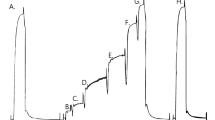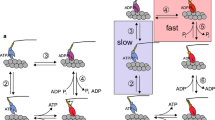Abstract
Mechanically skinned single fibres of the semitendinosus muscles of Rana esculenta were investigated at ca. 4‡ C. The fibres were activated by a Ca2+ jump technique, which allowed the development of a steady isometric tension within several seconds of entering a calcium rich solution at 4‡ C. Sequences of length changes of different duration and amplitude were applied to the fibre. It could be demonstrated that the fibre behaved as a Hookean spring in the case of small amplitude length changes (up to 0.5% L0, ramp duration 0.5 ms) and that a sequence of length changes induced reversible changes in fibre state. In contrast, large stretches (> 1% L0) induced a muscle “give” if the stretch were not immediately preceded by a release. The data was interpreted on the basis of a strain induced detachment of cross bridges in combination with a rapid reattachment of presumably the same cross bridges in a discharged position. The rates of strain induced detachment and reattachment depended on the stretch amplitude. At amplitudes exceeding 2% L0 the rates were estimated to be at least several thousands per second.
Similar content being viewed by others
References
Curtin NA, Davies RE (1973) Chemical and mechanical changes during stretching of activated frog skeletal muscle. Cold Spring Harbor Symp Quant Biol 37:619–626
Edman KAP (1966) The relation between sarcomere length and active tension in isolated semitendinosus fibres of the frog. J Physiol 183:407–417
Flitney FW, Hirst DG (1978a) Cross bridge detachment and sarcomere “give” during stretch of active frog's muscle. J Physiol 276:449–465
Flitney FW, Hirst DG (1979b) Filament sliding and energy absorbed by the cross bridges in activemuscle subjected to cyclical length changes. J Physiol 276:467–479
Ford LE, Huxley AF, Simmons RM (1977) Tension responses to sudden length change in stimulated frog muscle fibres near slack length. J Physiol 269:441–515
Goldmann YE, Simmons RM (1977) Active and rigor muscle stiffness. J Physiol 269:55–57
Güth K, Kuhn HJ (1978) Stiffness and tension during and after sudden length changes of glycerinated rabbit psoas muscle fibres. Biophys Struct Mech 4:223–236
Güth K, Kuhn HJ, Herzig JW, Rüegg JC (1978) Evidence for cross bridge slippage in a stretched muscle fibre. Experientia 34:1183–1184
Güth K, Kuhn HJ, Drexler B, Berberich W, Rüegg JC (1979) Stiffness and tension during and after sudden length changes of glycerinated single insect fibrillar muscle fibres. Biophys Struct Mech 5:255–276
Griffiths PJ, Kuhn HJ, Güth K, Rüegg JC (1979) Rate of isometric tension development in relation to calcium binding of skinned muscle fibres. Pflügers Arch 382:165–170
Harrington WF (1971) A mechanochemical mechanism for muscle contraction. Proc Natl Acad Sci USA 68:685–689
Holmes KC (1977) The myosin cross bridge as revealed by structure studies. In: Riecker G et al. (eds) Int. Symp. Rottach-Egern/Tegernsee, 1976. Springer, Berlin Heidelberg New York
Huxley AF (1957) Muscle structure and theories of contraction. Prog Biophys 7:255–318
Huxley AF (1974) Muscular contraction. J Physiol 243:1–43
Huxley AF, Simmons RM (1971) Proposed mechanism of force generation in striated muscle. Nature 233:535
Huxley AF, Simmons RM (1973) Mechanical transients and the origin of muscular force. Cold Spring Harbor Symp Quant Biol 37:669–680
Huxley HE (1965) Structural evidence concerning the mechanism of contraction in striated muscle. In: Paul WM et al. (eds) Muscle. Pergamon Press, New York, pp 3–29
Huxley HE (1969) The mechanism of muscular contraction. Science 164:1356–1366
Julian FJ, Morgan DL (1979a) Intersarcomere dynamics during fixed-end tetanic contractions of frog muscle fibres. J Physiol 293:365–378
Julian FJ, Morgan DL (1979b) The effect on tension of non-uniform distribution of length changes applied to frog muscle fibres. J Physiol 293:379–392
Machin KE, Pringle JWS (1959) The physiology of insect flight muscle: II. The mechanical properties of a beetle flight muscle. Proc R Soc Biol [Lond] 151:204–225
Mason P (1978) Dynamic stiffness and cross bridge action in muscle. Biophys Struct Mech 4:15–25
Sugi H (1972) Tension changes during and after stretch in frog muscle fibres. J Physiol 225:237–253
Sugi H (1979) The origin of the series elasticity in striated muscle fibres. In: Sugi H, Pollack G (eds) Cross bridge mechanism in muscle contraction. University of Tokyo Press, Tokyo, pp 85–102
Wray JS (1979) Structure of the backbone in myosin filaments of muscle. Nature 277:37–40
Yamamoto T, Herzig JW (1978) Series elastic properties of skinned muscle fibres in contraction and rigor. Pflügers Arch 373:21–24
Author information
Authors and Affiliations
Rights and permissions
About this article
Cite this article
Griffiths, P.J., Güth, K., Kuhn, H.J. et al. Cross bridge slippage in skinned frog muscle fibres. Biophys. Struct. Mechanism 7, 107–124 (1980). https://doi.org/10.1007/BF00538402
Received:
Accepted:
Issue Date:
DOI: https://doi.org/10.1007/BF00538402




